BASIC SHAOLIN KUNGFU AGAINST BOXING, KICK-BOXING, MUAY THAI AND WRESTLING
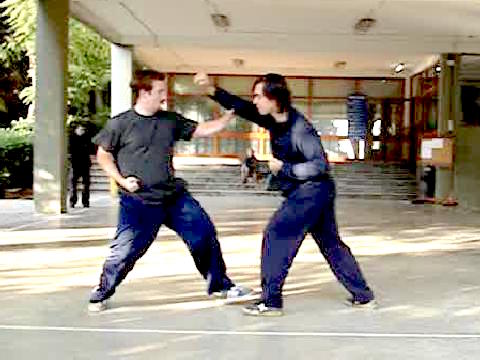
Tim using basic Shaolin Kungfu against a Boxer posed by Alex at the Barcelona Regional Shaolin Kungfu Course 2007
A question many people ask is whether a kungfu practitioner can use his kungfu against martial artists of other systems like Boxing, Kick-Boxing, Muay Thai and Wrestling, even when he can use it against other kungfu practitioners. In other words, if opponents use non-kungfu forms in their sparring or fighting, can he still be effective against them?
Of course he can — provided he is properly trained in kungfu application. But today most kungfu practitioners are unable to apply their kungfu against any opponents, no matter what martial arts these opponent use, certainly not because kungfu, whatever the style, is ineffective for combat, but simply because most kungfu practitioners today are not properly trained in kungfu combat application.
If you practice kungfu and would like to restore your dignity as one who practices kungfu as kungfu, and not as one who practices a dance and call it kungfu, or one who uses other martial techniques for sparring and call it kungfu, the video series here will help you to use kungfu for combat — irrespective of whether you win or lose — against opponents using Boxing, Kick-Boxing, Muay Thai and Wrestling.
These video series record the lessons of the regional Shaolin Kungfu course in Barcelona on 31st October, 1st and 2nd November 2007, organized by Sifu Adalia Iglesias. Please note that these video clips record only the 2nd and the 3rd day of the course when the participants, some of whom are beginners and most of whom are students of Sifu Daniel Perez of Shaolin Wahnam Spain, practiced Shaolin combat application. Lessons on the first day where the participants practiced the basics, particularly stance training and footwork, are not shown.
If you can perform some basic kungfu forms, you should be able to follow the lessons shown in the video clips without much difficulty. Of course, if you have a competent instructor to help you, your progress will be much enhanced. The kungfu skills and techniques shown here are elementary, but as most people today, irrespective of the styles they practice, use Boxing and Kick-Boxing in their sparring or fighting, these elementary skills and techniques should enable you to apply kungfu for some reasonable defence after you have put in some dedicated practice. Then you may progress to more sophisticated kungfu skills and techniques.
1. From Shaolin to Instinctive Fighting to Boxing
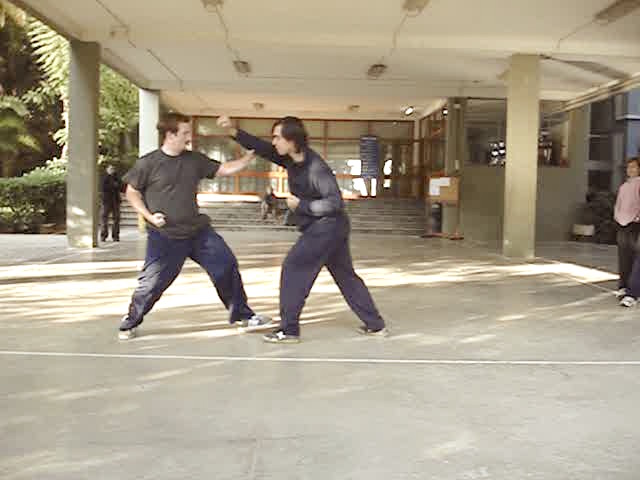
Should our form be picture-perfect, even in sparring or fighting? Of course. We have found from direct experience that the less perfect our form is, the more disadvantageous we become in both our defence and attack. Eventually, when we discard our kungfu form, we would be sparring instinctively, which is sparring without any art. When we spar instinctively but try to minimize disadvantages and maximize advantages we find ourselves sparring like what Boxers do.
2. Basic Counters against a Boxer's Jabs
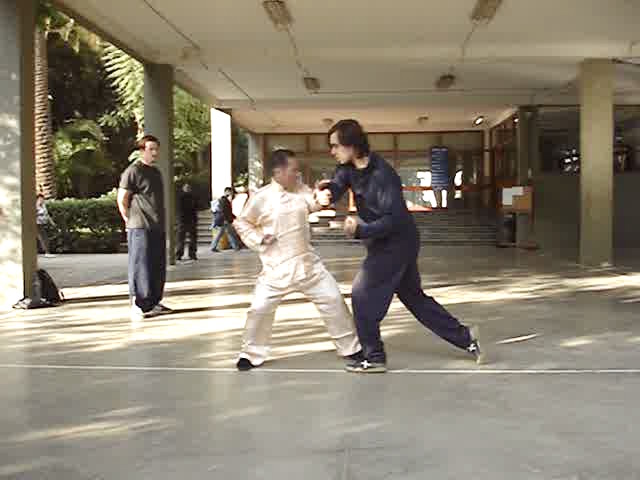
We may take a Boxer's jabs like “Black Tiger Steals Heart” and respond with “Single Tiger Emerges from Cave”. A better choice is to brush away his jabs using the Shaolin pattern “Kitten Washes Face”. An even better response is to use “Wave Dragon Back to Cave”. Here we not only brush away his attack but “tame” or cover it as well, making it difficult for him to continue attacking. We can then counter-attack with our “Black Tiger Steals Heart”.
3. Chasing after a Boxer's Retreat
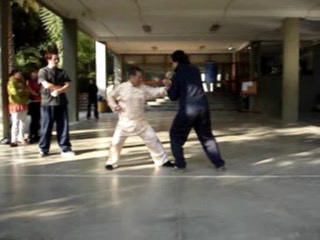
Pressing onto a Boxer to prevent him from moving forward, and simultaneously striking him is a good tactic. But a good Boxer may bounce away to avoid the press, and then bounce back to attack you. Anticipating this response, you can plan an effective counter-tactic against him. As soon as he bounces away, you follow closely to bridge whatever gap he wishes to create for his escape, still covering his hand and striking him. This tactic, or technique, is called the “chase”.
4. One-Step, Two-Step or Multiple-Step Chase
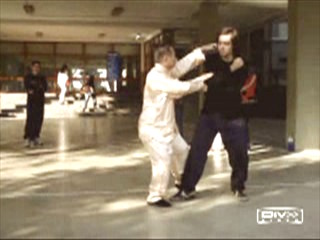
Depending on how far away an opponent retreats, your pursue can be a one-step, two-step, three-step or multiple-step chase. You should also chase according to his retreating direction, sticking to him like glue but covering him so that he cannot counter-attack you. It is your strikes that chase after your opponent; your footwork provides the right spacing. Understandably, you may be slow and hesitant initially, but with systematic training your chasing movement must be fast and spontaneous. You can refine both the smoothness of your movement and the extent of your reach by using appropriate stances.
5. Practicing on your Own, then Testing it on your Partner
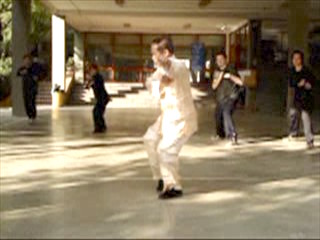
The various steps of chase become fluid, fast and spontaneous only after systematic training. You should practice the movements on your own, testing them out with sparring partners only after you have become quite proficient. Initially, go over the movements slowly and correctly, but with continued practice your movements will be fast and spontaneous. The movements shown in the video clips below are examples. While there are definite principles and guidelines, there are no fixed movements in the chase, it follows the spacing and direction of the opponent's retreat.
6. Counters against a Boxer's Left Jabs

A Boxer usually uses left jabs instead of right jabs. His typical tactic is to use left jabs to pave the way for a powerful right punch. But we start with the Boxer's right jabs mainly for systematic progression. We use our left Single Tiger against a Boxer's right jabs. The next progression is to change our left Single Tiger to our left Wave Dragon or left Kitten. When we are quite proficient in these responses to a Boxer's right jabs, we can progress to handling his left jabs. This video series shows various methods we can employ to counter a Boxer's left jabs.
7. Handling Unexpected Attacks Correctly and Spontaneously
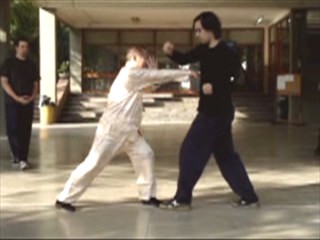
In real fighting a Boxer does not throw only one jab and freeze for you to counter. But when you can successfully counter a left jab, or a right punch, and understand its underlying principles, you can progress to counter many left jabs and right punches. This video series shows these and other methods to counter the attacks of a Boxer, including how to respond correctly and spontaneously to his unexpected attacks.
8. Progressing to Realistic Sparring with a Boxer
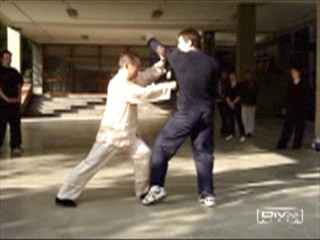
Having learnt the various counters against the Boxer's jabs and crosses, we can now progress to more realistic sparring with the Boxer. A good strategy is to close the Boxer, and then strike him. We can also open him to attack. Using the left hand to guard or pave the way, and the right hand to strike is an effective strategy. A Boxer is not only fast, but he often uses feint moves. A good tactic is to cover his moves, irrespective of whether they are feint or real. Good body-movement and footwork are needed to implement this tactic successfully.
9. Employing Appropriate Tactics to Defeat a Boxer
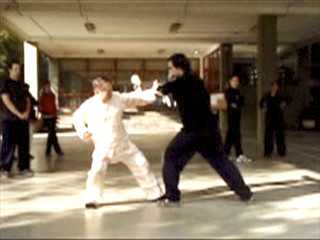
“Know yourself, know your enemy, and you will win every battle” advised Sun Tzu, the great strategist, in his Art of War. If you know how a Boxer typically fights, and devise appropriate tactics to fight him accordingly, you will have a good chance of beating him. Typically a Boxer throws leading jabs with his left hand, and follows up with a powerful cross-strike with his right hand. A good tactic is to brush away his jabs and close him so that it is difficult for him to throw further jabs or crosses. Then you strike him to clinch victory.
10. Sticking to a Boxer as he tries to Bounce Away
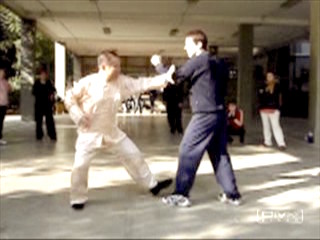
When you have closed a Boxer effectively, he cannot strike you or move forward. You can then strike him repeatedly. His likely escape is to bounce back. As he bounces back, you should chase him, “taming” his hands at the same time. The space taken by a Boxer's bouncing is short. Usually you can cover the same space in one step that a Boxer needs to bounce back twice. Hence, you have superior technical speed over a Boxer. In other words, when a Boxer tries to escape by bouncing away, you can easily cover the space and still close him and strike him.
11. Advantages of the Bow-Arrow Stance over the Boxer's Footwork
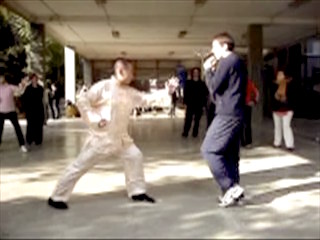
Stances give Shaolin Kungfu practitioners many advantages over Boxers. The Box-Arrow Stance is very useful when fighting against Boxers. When you extend your hands while sitting at a Bow-Arrow Stance, for example, it is difficult for a Boxer to move in to attack you. By sinking the Bow-Arrow Stance backward, you can avoid a Boxer's attacks without having to move your legs. Then you can shift your body forward again to strike him. This gives you superior technical speed. A step in a Bow-Arrow Stance covers about the same space a Boxer makes in two steps of bouncing. This again gives a Shaolin practitioner technical speed.
12. Practicing Numerous Tactics against Boxers
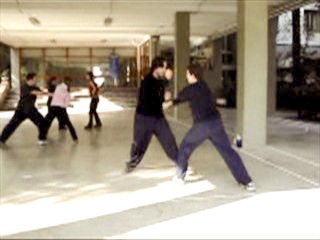
Participants at the Barcelona regional Shaolin Kungfu course of October 2007 put into action numerous tactics taught by Grandmaster Wong against Boxers. Basically they brush away a Boxer's jabs, and close him so that he cannot counter-attack, They then strike the Boxer with level fists or leopard punches. If the Boxer tries to retreat, they chase accordingly,
13. Handling a Boxer Competently Despite his Speed and Size
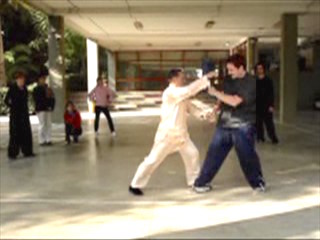
Today irrespective of what martial arts your opponents practice, they are likely to fight like Boxers, and sometimes as Kick-Boxers. Hence, if you wish to be combat efficient, you must be able to handle a Boxer competently. Then you progress to handling a Kick-Boxer. Handling a Boxer is actually quite simple — if you know how. But besides knowing the techniques, you must also develop the necessary combat skills. The video series here provides some excellent training material. You can also competently handle a Boxer who may be fast, bigger in size and has longer reach than you.
14. Understanding and Implementing Techniques, Tactics and Skills against Boxers
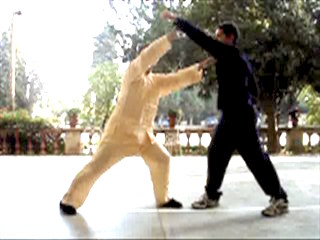
As a Boxer's techniques are limited, it is technically easy to handle him. His main techniques are jabs, crosses, hooks and undercuts. Our main tactics are to brush away his attacks, close him so that it is difficult for him to continue attacking, and strike him. When he tries to escape by bouncing away, we chase after him. You must remember that it is not enough just to know the techniques and tactics; you must also have the skills to carry out the techniques and tactics successfully. There are many other tactics to handle a Boxer competently, like kicking and felling him. We shall leave these other tactics to later lessons. Even the present tactics explained so far are sufficient to handle a Boxer competently.
15. Countering the Left-Left-Right of Boxers

A favorite tactic of a Boxer is to throw some light left jabs, then follows with a solid right cross. This is code-named “left-left-right” or “1-1-2”. Sometimes it may just be “left-right” or “1-2”. An effective counter tactic is to brush away his left attacks, move in to “tame” his both hands, and strike him. If he moves back, close up with one-step, two-step or multiple-step chase, continuing to strike him with Black Tigers or Golden Leopards.
16. Kick a Boxer Whenever he Uses his Right Hand

Handling a Boxer is technically easy. This is because a Boxer's techniques are limited. But this does not necessarily mean you will defintely defeat a Boxer. If he is skillful, he can beat you even when you know many techniques against him. There are actually many effective ways to handle a Boxer. One effective way or strategy dealt with in this video series is to apply kicks. There are a few tactics to implement this strategy. One useful tactic is to kick him whenever he uses his right hand.
17. Various Tactics to Handle a Boxer

Besides kicking a Boxer as soon as he uses his right hand, you can also kick him when he uses his left. For convenience, this tactic is called “kick when left”. There are also other tactics to handle a Boxer. The class goes over the numerous other tactics learnt and practiced in previous lessons, such as closing or opening the Boxer and simultaneously striking him.
18. Attacking a Boxer with a Planned Sequence
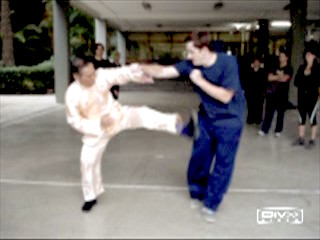
An excellent way to fight a Boxer is to kick him. He has no techniques in his whole Boxing repertoire to counter kicks! Of course you can kick him more than once. Indeed, if you repeatedly kick him, most Boxers would be at a loss as what to do. You can also devise other planned attacks against a Boxer after initiating with kicks. One effective way is to close him and strike him continuously. Your chance of beating him will be much enhanced if you attack him with a planned sequence.
19. Felling a Boxer as he Attacks with an Undercut

Undercuts, known as “thong thien pau” or “Cannons to the Sky”, are formidable attacks. Many people are at a loss as how to deal with such attacks as they can be very powerful. Actually they can be countered quite easily — if you know how. Firstly, don't block an undercut or a “Cannon to the Sky”. Doing so may break your wrist or arm, or at best places you in an unfavorable position.
A good counter is to sink back to avoid the undercut, then move forward to fell the opponent. The video clips in this series will show you how.
20. Various Ways to Fell an Opponent
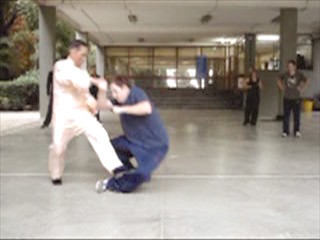
There are many ways to fell an opponent. Three main ways, with different variations, are demonstrated and explained in this video series, and they are implemented in the patterns “Fell Tree with Roots”, “Lead Horse Back to Stable” and “White Crane Steps on Snow”. Certain techniques are more useful in particular situations. But when you are familiar with these techniques, you can use any of the techniques to fell them easily.
21. Knee Strikes and their Counters
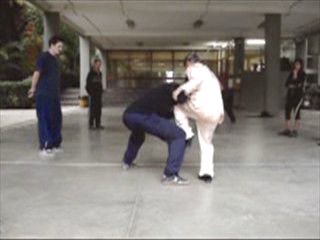
Having learnt the counters against Boxers, we progress to counters against Kick-Boxers and Muay Thai fighters. The Muay Thai knee strike is formidable, feared by many martial artists. Such knee attacks are found in Shaolin Kungfu, such as in “Golden Cockerel Stands Solitarily”. In fact knee strikes in Shaolin Kungfu are more refined because we have to take care of our own safety while applying the strikes, whereas Muay Thai fighters normally pay little attention to such precaution as they are protected by safety rules.
22. From Simple Techniques to Sophisticated Patterns
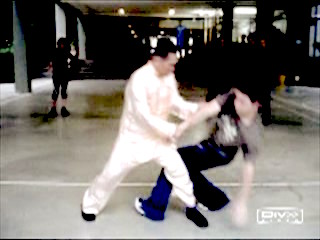
Some people think that kungfu patterns are too complicated to be combat effective. They believe, incorrectly, that techniques are effective for fighting only when they are simple, like straight-forward punches and kicks.
But even an elementary Shaolin Kungfu class like this one in Barcelona in October 2007 shows that when fighting progresses to higher levels, more sophisticated techniques are needed. If an opponent successfully grips your arm, for example, relying only on Boxing techniques would be inadequate.
23. Why Many Kungfu Practitioners are Unable to Counter Muay Thai and Kick-Boxing Attacks
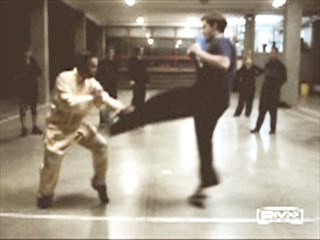
Why many kungfu practitioners as well as many other martial artists are unable to defend against ferocious Muay Thai attacks? The main reason is that they do not know the counter techniques. Many kungfu practitioners only practice forms but not combat application. Many other martial artists may practice free sparring but they mostly punch and kick widely. Of course, skills are very important. But first of all they need the techniques upon which to build their skills. This video series show some useful techniques against Muay Thai fighters and Kick-Boxers.
24. Superiority of Kungfu Stances, Footwork and Techniques
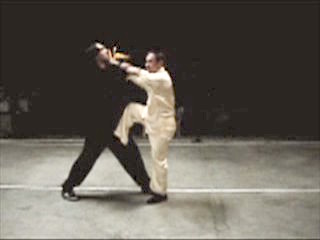
If we just discuss techniques, there is no doubt that Shaolin techniques are superior to those of other martial arts. Even the few examples in this video series can justify this claim. But we have no illusion that superior techniques are usually not the decisive factor in combat. Skills are far more important. Hence, despite our superior techniques, a skillful Muay Thai fighter or Kick-Boxer can defeat us. But if we have superior techniques, we shall be more cost-effective in acquiring skills.
25. Counters against Muay Thai and Kick-Boxing Attacks

Technically, it is not difficult to defend against or counter attacks of Muay Thai fighters or Kick-Boxers. They, why do many kungfu practitioners become helpless when faced with such attacks? The straight-forward answer is that they do not know any self-defence — regardless of whether the attacks come from Muay Thai fighters, any other martial artists or even any untrained persons! But we must not forget that merely knowing the tactics and techniques is insufficient. You must also have the necessary skills, like force, speed and stamina.
26. Effective Tactics and Techniques against Continuous Attacks Mixed with Feint Moves

A Muay Thai fighter is not only fast but also very tricky. He frequently uses false moves. Before you can ward off an attack, another one follows swiftly. How would you defend against or counter such continuous attacks mixed with feint moves. A good way is to cover his hands so that he has little or no chance to make any moves. Then strike him continuously while maintaining the coverage. If he kicks, avoid his kicks without moving your feet, and simultaneously strike his kicking legs. As soon as he drops his leg, cover him and strike him continuously.
27. How do you Counter Continuous Kicks

Many people move back when an opponent attacks. This is a big mistake. You should stand at your stance, and move in to counter-attack when appropriate. Make good use of your stances. You can avoid his kicks as well as hand strikes by shifting your body backward without moving your feet. If he kicks, strike his kicking legs. If he strikes, cover his hands and move in to counter-attack. These tactics and techniques are actually at the beginning level of our sparring methodology. But if you use them skillfully, they can be very effective for combat.
28. Exploiting the Innate Weaknesses of Kicks to Counter Them

There are many ways to counter kicks by exploiting their innate weaknesses. Using body-movement to avoid the kick and simultaneously strike the kicking leg is an effective way. Intercepting a kick, especially one that takes some time to reach its target, is another. Felling an opponent as he kicks is a third way. Many martial artists are not accustomed to these counters. It is because in their arts, which are actually sports, they are not allowed to do so. In real combat such restrictions give kungfu exponents numerous advantages, but many kungfu practitioners do not know how to exploit these advantages nor the innate weaknesses of kicks.
29. Throwing an Opponent as he Kicks

An effective counter against kicks is to throw the attacker onto the ground. Such throws are often decisive as it may break the opponent's skull, spine or limbs. Many martial artists, including some masters, throw their opponents without adequate coverage for their own safety! This unbelievable negligence is due to the fact that the martial arts they practice are actually sports where safety rules forbidding attacks on vital and deadly points. Genuine, traditional kungfu is trained as a fighting art. Hence, ensuring safety before making an attack is of paramount importance.
30. Striking the Attacker as he Attempts a Shoot

Many people forget that wrestling is a sport with safety rules. Using the “shoot”, a popular wrestling technique, in a real fight is suicidal. The attacker dangerously exposes his head to be struck. Assuming the opponent is not skillful or knowledgeable enough to strike is silly. There are many counters against the shoot. These counters may be classified into three categories — before the attacked has grabbed your legs, when the attacker has successfully grabbed your legs, and when the attacker has taken you down on the floor.
31. Countering the Shoot as an Attacker has Grabbed you or Pushed you onto the Ground

Without safety rules, applying the shoot is suicidal. The attacker exposes his head dangerously for us to strike. If we fail to strike him, it is not because the counter is ineffectual, but because we lack the skill to make it work. But even if we fail to strike and the attacker has grabbed our waist or legs, we also have many techniques to counter the attack. Some of these counters may result in breaking the attacker's neck or back, or causing serious injury to his head. Even if we fail this, and is being pushed onto the ground, se still have counters against the shoot.
LINKS
Basic Shaolin Kungfu against Boxing, Kick-Boxing,
Muay Thai and Wrestling
- From Shaolin to Instinctive Fighting to Boxing
- Basic Counters against a Boxer's Jabs
- Chasing after a Boxer's Retreat
- One-Step, Two-Step or Multiple-Step Chase
- Practicing on your Own, then Testing it on your Partner
- Counters against a Boxer's Left Jabs
- Handling Unexpected Attacks Correctly and Spontaneously
- Progressing to Realistic Sparring with a Boxer
- Employing Appropriate Tactics to Defeat a Boxer
- Sticking to a Boxer as he Tries to Bounce Away
- Advantages of the Bow-Arrow Stance over a Boxer's Footwork
- Practicing Numerous Tactics against Boxers
- Handling a Boxer Competently despite his Speed and Size
- Understanding and Implementing Techniques, Tactics and Skills against Boxers
- Countering the Left-Left-Right of Boxers
- Kick a Boxer Whenever he Uses his Right Hand
- Various Tactics to Handle a Boxer
- Attacking a Boxer with a Planned Sequence
- Felling an Opponent as he Attacks with an Undercut
- Various Ways to Fell an Opponent
- Knee Strikes and their Counters
- From Simple Techniques to Sophisticated Patterns
- Why many Kungfu Practitioners are Unable to Counter Muay Thai and Kick-Boxing Attacks?
- Superiority of Kungfu Stances, Footwork and Techniques
- Counters against Muay Thai and Kick-Boxing Attacks
- Effective Tactics and Techniques against Continuous Attacks Mixed with Feint Moves
- How do you Counter Continous Kicks?
- Exploiting the Innate Weaknesses of Kicks to Counter Them
- Throwing an Opponent as he Kicks
- Striking the Attacker as he Attempts a Shoot
- Countering the Shoot when an Attacker has Grabbed you or Pushed you onto the Ground
